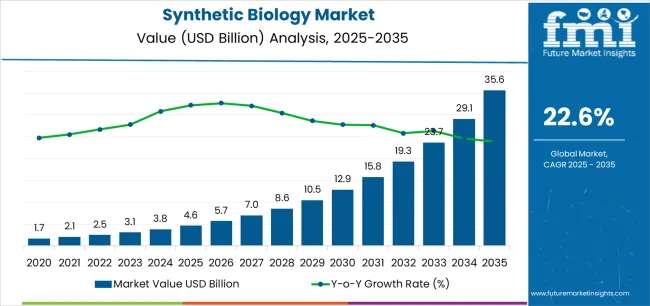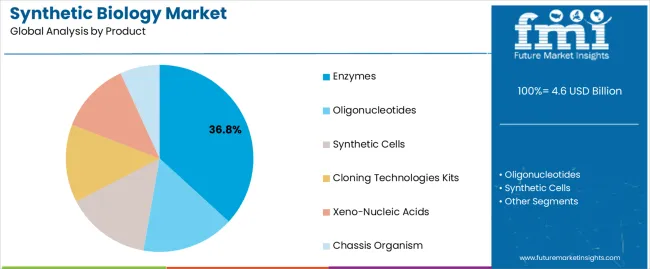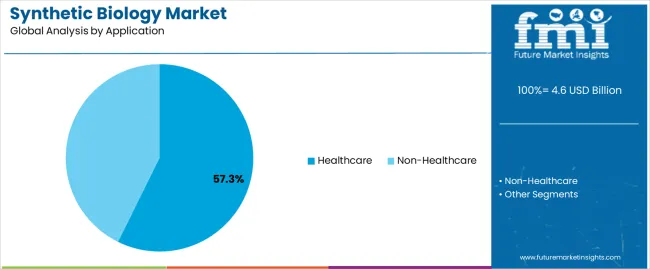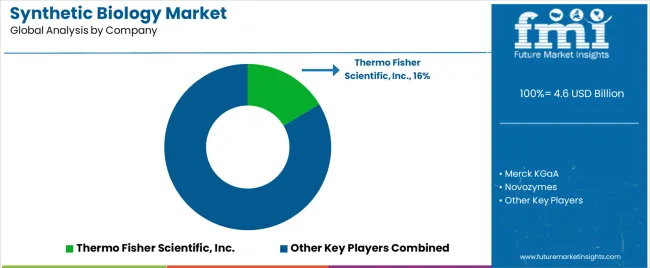The Synthetic Biology Market is estimated to be valued at USD 4.6 billion in 2025 and is projected to reach USD 35.6 billion by 2035, registering a compound annual growth rate (CAGR) of 22.6% over the forecast period.
The synthetic biology market is expanding at a strong pace, propelled by rapid advancements in gene editing, DNA synthesis, and metabolic engineering technologies. The growing application of synthetic biology in healthcare, agriculture, and industrial biotechnology is transforming multiple sectors.
Increasing investments from both public and private institutions, coupled with favorable regulatory support for bio-innovation, have accelerated commercialization. The market benefits from expanding biomanufacturing capabilities and the rising need for sustainable biological alternatives to chemical processes.
The convergence of artificial intelligence with biological design tools is further improving research precision and scalability. As industries seek efficient, low-carbon production pathways, synthetic biology is emerging as a key enabler of next-generation biotechnology and sustainable industrial transformation.

| Metric | Value |
|---|---|
| Synthetic Biology Market Estimated Value in (2025 E) | USD 4.6 billion |
| Synthetic Biology Market Forecast Value in (2035 F) | USD 35.6 billion |
| Forecast CAGR (2025 to 2035) | 22.6% |
The market is segmented by Product, Application, and End User and region. By Product, the market is divided into Enzymes, Oligonucleotides, Synthetic Cells, Cloning Technologies Kits, Xeno-Nucleic Acids, and Chassis Organism. In terms of Application, the market is classified into Healthcare and Non-Healthcare. Based on End User, the market is segmented into Biopharmaceutical Manufacturers, Academic And Government Research Institutes, and Others. Regionally, the market is classified into North America, Latin America, Western Europe, Eastern Europe, Balkan & Baltic Countries, Russia & Belarus, Central Asia, East Asia, South Asia & Pacific, and the Middle East & Africa.

The enzymes segment holds approximately 36.8% share of the product category in the synthetic biology market. This dominance is attributed to the growing utilization of engineered enzymes in pharmaceuticals, biofuels, and industrial biocatalysis.
Enzymes developed through synthetic biology techniques offer superior stability, specificity, and yield compared to naturally derived counterparts. Their adoption supports cost-effective and environmentally sustainable production processes.
The segment’s growth is further reinforced by increased R&D investments in enzyme engineering for customized applications. With ongoing advancements in computational biology and protein design, the enzymes segment is expected to remain a cornerstone of synthetic biology innovation.

The healthcare segment leads the application category, accounting for approximately 57.3% share. This segment’s prominence is driven by the use of synthetic biology in drug discovery, gene therapy, vaccine development, and diagnostics.
The technology enables rapid prototyping of biological systems for targeted disease treatment and prevention. Increased focus on precision medicine and synthetic vaccines has expanded the market scope within this segment.
The integration of cell-free synthesis and genetic circuit design is enhancing the efficiency of biomedical innovation. With rising investment in clinical research and biologics manufacturing, healthcare applications are projected to sustain their market dominance.

The biopharmaceutical manufacturers segment holds approximately 41.6% share of the end-user category, reflecting the increasing industrialization of synthetic biology. These manufacturers leverage engineered microorganisms and cell systems to produce biologics, enzymes, and bio-based materials at scale.
The segment benefits from growing partnerships between biotech firms and pharmaceutical companies aimed at accelerating product development. Expansion of GMP-certified facilities and automation in biomanufacturing processes has improved production efficiency and quality control.
With strong capital inflows and the continuous emergence of bio-based therapeutics, biopharmaceutical manufacturers are expected to remain the leading end-user group driving market advancement.
This section provides a comprehensive analysis of the market during the last five years, highlighting the expected growth patterns. The market is changing steadily, as seen by its strong historical CAGR of 21.7% from 2020 to 2025. Based on sustained growth at a 23.8% CAGR through 2035, the industry is predicted to expand in the future.
| Historical CAGR | 21.7% |
|---|---|
| Forecast CAGR | 23.8% |
The global synthetic biology market is expected to face growth barriers from ethical issues, regulatory constraints, and public mistrust about safety.
Crucial factors that are anticipated to affect the demand for synthetic biology through 2035.
Market players are anticipated to need to be astute and adaptable during the anticipated period, as these tough aspects position the industry for future development.
Renewability of the Bio-Based Chemicals Fuels the Synthetic Biology Industry
The growing need for bio-based products and sustainable energy is driving tremendous expansion in the synthetic biology sector. Novel biological systems that can economically and sustainably manufacture a variety of molecules, such as industrial chemicals, medicines, and biofuels, have been made possible using artificial biology approaches.
The advancements in genetic engineering, metabolic engineering, and synthetic biology tools have enabled researchers to engineer microorganisms to produce high-value chemicals and fuels from renewable resources such as biomass, algae, and waste materials.
This has opened up new avenues for developing sustainable and eco-friendly products to address the growing concerns of environmental pollution and energy security, propelling the growth of the global synthetic biology industry.
Rising Interest in Cost-Effective Drugs and Vaccines Surging Market Demand
Global interest in synthetic biology has increased due to the growing need for affordable medications and vaccinations. A whole new range of opportunities for drug discovery and precision medicine are made possible by synthetic biology approaches, which provide a distinctive and inventive approach to designing and engineering biological systems.
Modern developments in synthetic cell biology allow researchers to design whole biological systems, alter already-existing ones, or build new physical components to produce unique solutions.
The goal of creating safe, efficient, and reasonably priced medications and vaccines for a range of illnesses and ailments has LED to a rapid expansion of the global synthetic biology industry.
Synthetic Biology Provides Fertile Ground for Genetically Modified Crops
The increased acceptance of genetically modified crops is driving the demand for synthetic biology products in the global market. The demand for sustainable food supplies has grown urgently due to the rising global population.
One practical way to address this problem is through synthetic biology, which can enhance the crop production process. Scientists and researchers can employ improvements in gene editing technology to make crops more resistant to pests and diseases, have longer shelf lives, and produce larger yields.
These benefits drive the adoption of synthetic biology in the agriculture sector and are expected to propel market growth in the coming decade.
| Attributes | Details |
|---|---|
| Top Product | Oligonucleotides |
| Market share in (2025) | 43.60% |
The demand for oligonucleotides is anticipated to rule the synthetic biology market, with an advantageous market share of 43.6% in 2025. Several reasons exist for this inclination for oligonucleotides in the global synthetic biology market:
| Attributes | Details |
|---|---|
| Top End User | Biopharmaceutical Manufacturers |
| Market share in 2025 | 43% |
In 2025, biopharmaceutical manufacturing is expected to account for a leading market share of 43%. The following reasons are driving the segment’s growth:
| Countries | CAGR from 2025 to 2035 |
|---|---|
| United Kingdom | 19% |
| China | 26% |
| India | 27% |
| Japan | 12.5% |
| Germany | 14.8% |
The United Kingdom's synthetic biology industry is expected to develop at a staggering CAGR of 19% from 2025 to 2035. The following factors are driving the demand for synthetic biology, which is anticipated to play a crucial role in the growth of the United Kingdom's biopharmaceutical sector:
The German synthetic biology industry is anticipated to acquire a market share of 8% and is projected to demonstrate an impressive CAGR of 14.8% from 2025 to 2035. Some of the primary drivers of the growth of the German synthetic biology sector include:
The Chinese market for synthetic biology is poised to rise at a staggering CAGR of 26% through 2035. Among the main trends in the development of the synthetic biology market in China are:
From 2025 to 2035, the Indian market for synthetic biology is anticipated to grow at a consistent rate of 27% CAGR. The following are some significant patterns illustrating the growth of Indian synthetic biology:
The Japanese synthetic biology market is well-positioned to be a catalyst for pharmaceutical innovation due to its substantial development potential. The market is projected to expand at a 12.5% CAGR from 2025 to 2035, gaining a 5.70% market share. Some of the key developments propelling the market's growth are as follows:
The future and trajectory of the global synthetic biology industry are significantly shaped by market participants through their innovative approaches, collaborative efforts, and strategic investments.
These businesses are at the forefront of creating innovative technologies, spearheading R&D initiatives, and bringing synthetic biology solutions to market across various industries.
Organizations such as Agilent Technologies, Inc. and Thermo Fisher Scientific, Inc. constantly push the frontiers of synthetic biology by investing in research and development and creating new instruments, methods, and applications.
They use synthetic biology to tackle urgent environmental and societal issues, including customized health, renewable energy generation, and sustainable agriculture.
Establishments such as Medichem and Bota Bio fuel market growth by forming strategic alliances and working with universities, research centers, and other business stakeholders.
These partnerships promote technology transfer, information sharing, and the creation of new synthetic biology goods and services. Corporations proactively collaborate with regulatory bodies to effectively manage the intricate regulatory framework for synthetic biological products.
By guaranteeing compliance and resolving ethical and safety issues, businesses are gaining the faith and confidence of investors, regulators, and consumers in synthetic biology technology.
Market players are driving innovation, accelerating market adoption, and shaping the future of the global synthetic biology industry, positioning it as a key driver of economic growth and technological advancement in the forthcoming decade.
Recent Developments in the Synthetic Biology Industry

The global synthetic biology market is estimated to be valued at USD 4.6 billion in 2025.
The market size for the synthetic biology market is projected to reach USD 35.6 billion by 2035.
The synthetic biology market is expected to grow at a 22.6% CAGR between 2025 and 2035.
The key product types in synthetic biology market are enzymes, oligonucleotides, synthetic cells, cloning technologies kits, xeno-nucleic acids and chassis organism.
In terms of application, healthcare segment to command 57.3% share in the synthetic biology market in 2025.






Full Research Suite comprises of:
Market outlook & trends analysis
Interviews & case studies
Strategic recommendations
Vendor profiles & capabilities analysis
5-year forecasts
8 regions and 60+ country-level data splits
Market segment data splits
12 months of continuous data updates
DELIVERED AS:
PDF EXCEL ONLINE
Synthetic Dye Market Forecast Outlook 2025 to 2035
Synthetic Data Generation Market Size and Share Forecast Outlook 2025 to 2035
Synthetic Abrasives Market Size and Share Forecast Outlook 2025 to 2035
Synthetic Zeolite Y Adsorbent Market Size and Share Forecast Outlook 2025 to 2035
Synthetic Musk Market Size and Share Forecast Outlook 2025 to 2035
Synthetic Tackifiers Market Size and Share Forecast Outlook 2025 to 2035
Synthetic Spider Silk Proteins Market Analysis - Size, Share, and Forecast Outlook 2025 to 2035
Synthetic Polymer Wax Market Size and Share Forecast Outlook 2025 to 2035
Synthetic Aperture Radar (SAR) Market Size and Share Forecast Outlook 2025 to 2035
Synthetic Diamond Market Size and Share Forecast Outlook 2025 to 2035
Synthetic Turf Market Size and Share Forecast Outlook 2025 to 2035
Synthetic Food Market Size and Share Forecast Outlook 2025 to 2035
Synthetic Polyisoprene Rubber Market Report – Trends & Innovations 2025–2035
Synthetic and Bio Emulsion Polymer Market Size and Share Forecast Outlook 2025 to 2035
Synthetic And Bio Based PMMA Polymethyl Methacrylate Size Market Size and Share Forecast Outlook 2025 to 2035
Synthetic Quartz Market Size and Share Forecast Outlook 2025 to 2035
Synthetic Leather Market Forecast & Growth 2025 to 2035
Synthetic Quartz Industry Analysis in Japan - Size, Share, & Forecast Outlook 2025 to 2035
Synthetic Food Color Market Analysis - Size, Share, and Forecast Outlook 2025 to 2035
Synthetic Paper Market Insights - Growth & Trends Forecast 2025 to 2035

Thank you!
You will receive an email from our Business Development Manager. Please be sure to check your SPAM/JUNK folder too.
Chat With
MaRIA